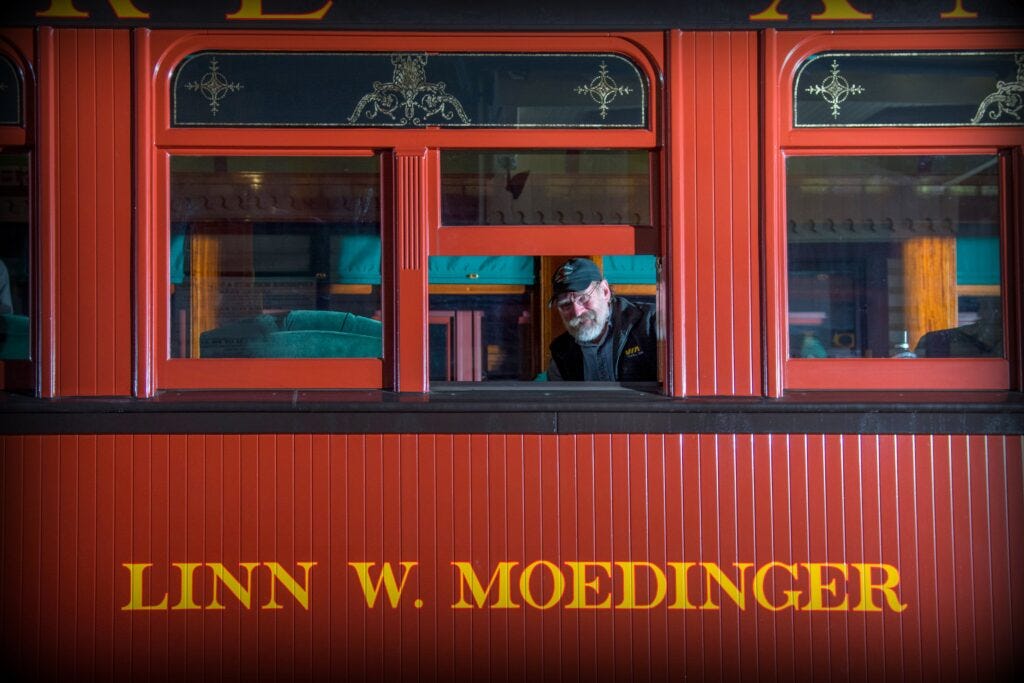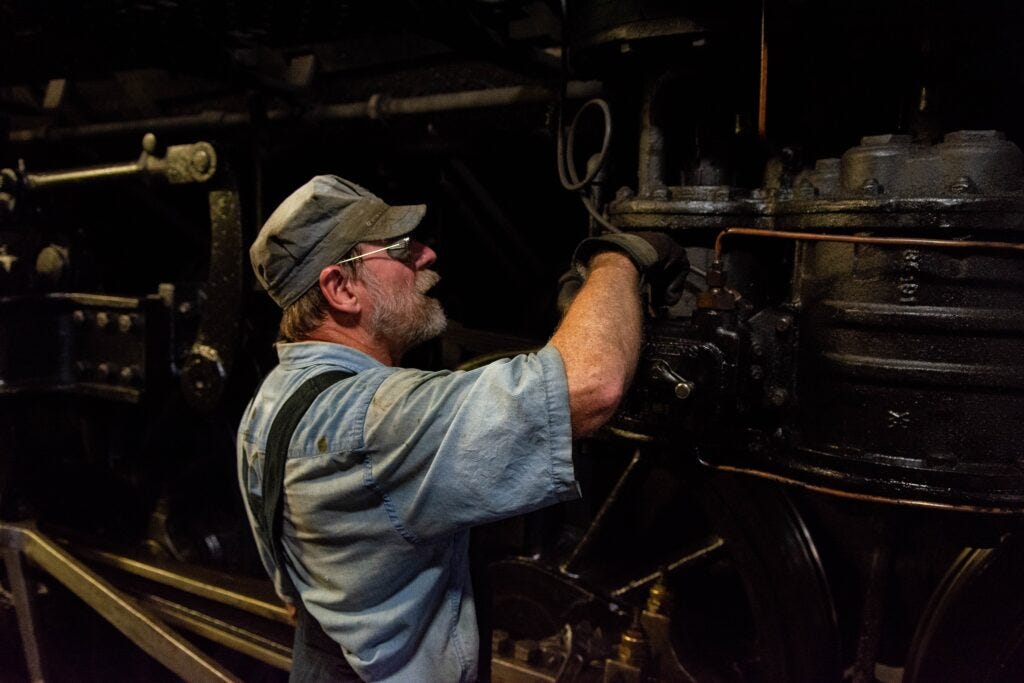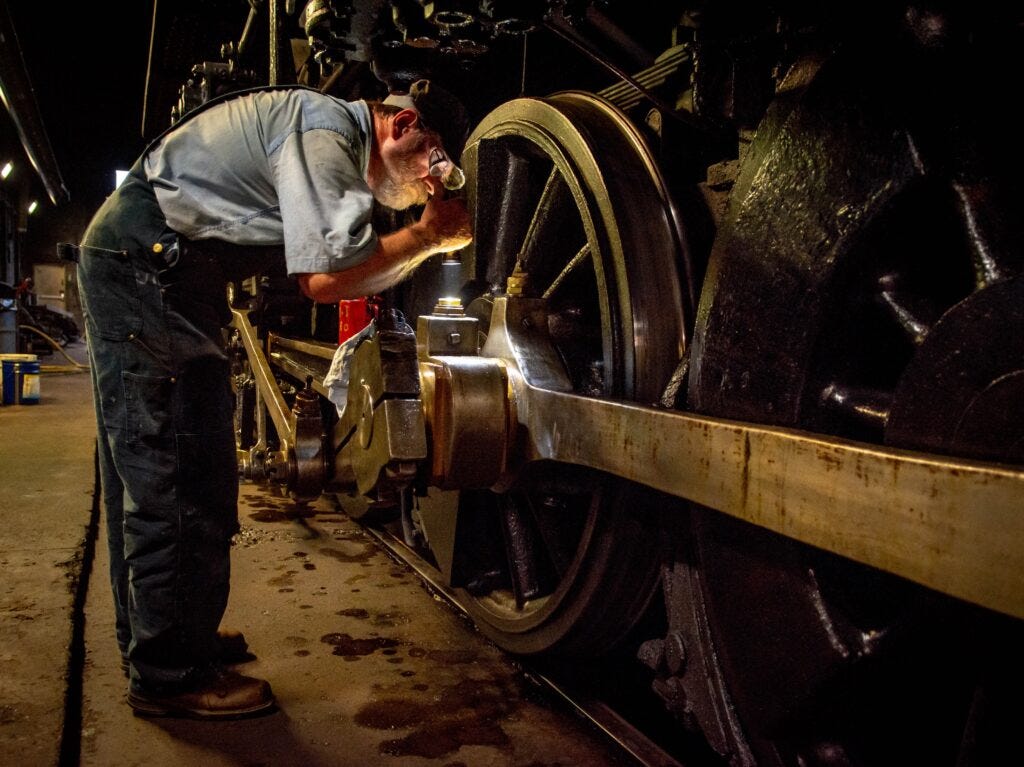Linn Moedinger – Preservation Heavyweight
Behind the Throttle - Edition 1, Installment 12
“[Trains are] an important teaching tool of a time before drones brought packages to your door”
Linn Moedinger enjoying the comfort of his namesake car at The Strasburg Rail Road. Photo by Chris Pollock.
The year is 2020. It’s been just about 70 years since steam locomotives were put out to pasture as the more efficient diesels ushered in a new era of railroading. 70 years since the golden age of railroading, 70 years since trains lost a part of their soul that made them so widely loved. In that time, several people have stepped up to fill the role as voices of the past, helping illustrate to the public what railroading once was, and what the livelihood of our nation was founded upon. Through a career lasting about 50 years, today’s subject has immortalized himself as a household name among preservationists. Today, we take a look at the life of a true man of steam, Linn Moedinger.
Linn was born into the height of passenger railroading in the early 1950s. With his father working aboard the legendary Pullman sleeper cars, it’s no wonder why Linn was so infatuated with trains from a young age. Linn recalled several times when he rode the trains his father worked on, such as riding the rails into Philadelphia aboard the Pennsylvania Railroad’s long-haul trains that took passengers from the epicenter of the East Coast, all the way west to Pittsburgh and Chicago. Meeting his father at Lancaster station, Linn recalled a specific trip where after following his dad back and forth between the cars, watching him perform his duties to ensure the safety and comfort of the passengers, he retired to an empty lower section where he slept soundly as the train rocked across the Pennsylvania Railroad’s east-west mainline.
Linn banks the fire on Strasburg 89 after a day of running trips on the road to paradise. Photo by Chris Pollock.
In 1968, Linn began to follow his father’s footsteps and applied for a job at the nearby Strasburg Rail Road. Hired by Huber Leath, one of the original investors in the railroad, Linn got his beginnings at the railroad working in the grounds/maintenance sector, where he performed the glamorous duty of cleaning toilets. While working with the groundskeeping department, Linn also began to help out in the mechanical shops at the railroad, cleaning engine parts for the railroad’s 44 tonner. In June of 1969, after working part-time at the railroad for a little under a year, Linn began working full-time in the mechanical shops and as a fireman aboard the railroad’s steam powered passenger ride. Linn worked at the railroad until November of 1969, where he then enlisted in the Army and went into service December of that year. Upon his discharge from military duty, Linn came back to the Strasburg Rail Road, and was soon tasked with being the “engine messenger” for the railroad’s newly acquired locomotive. Former Canadian National locomotive No.89 was purchased from the Green Mountain Railroad in Bellows Falls, VT, after the locomotive was submerged by floodwaters resulting from Hurricane Agnes. Once 89 was safe and sound at her new home, Linn began an apprenticeship working in the boiler shop, where he spent four years shadowing men straight out of the steam era.
In 1975, Linn decided it was time for a change of scenery, and took a leave from Lancaster County to tour the great American countryside. On this great road trip, Linn soon found himself with another steam railroad, the Heber Valley in Heber City, Utah. Working with this railroad and their 1906-built steam locomotive further hooked Linn into the world of railroading. When he returned to Strasburg following this great adventure, he further involved himself with the steam side of the operations and began working with the contracting department at the railroad. Linn was sent all over the country to assist other railroads with their own steam adventures, even going back to the Heber Valley just a few years after visiting for the first time. In 1988, Linn was promoted to the position of Chief Mechanical Officer of the railroad, a position his younger self hadn’t dreamed of. In the following years, alongside his work at Strasburg, Linn would go on to help create a set of recommended guidelines for steam locomotive operation in a tourist scenario. Many of the Federal Railroad Administration’s modern guidelines for steam operations can be attributed to the recommendations that he helped create in 1991 (Unfortunately, these recommendations would not be heeded until after the Gettysburg Railroad had a crown sheet failure in 1995). In 2000, Linn was elected president of Strasburg Railroad. He remained in this position until his retirement in 2018, when his near half-century career with America’s oldest operating shortline finally came to a close.
Linn hostling the very same locomotive that he helped bring to the Strasburg. Photo by Chris Pollock.
Linn’s life of working in the rail industry has been shaped by hard work, passion, and a desire to preserve the industry that built our country from the ground up. Asking to Linn to reflect on his time with the railroads, he told me that he was overall satisfied with his ratio of successes to failures in his own endeavors, and also remarked on the importance of those failures as learning moments. When I asked Linn to tell me about a vivid memory, he took me back to 1968 to when he fired a steam locomotive for the first time on his own. On that day, the scheduled fireman was injured in a freak accident involving the door to the enginehouse, so Linn was called in to fill his role. Having only fired a few times before as a student, Linn was nervous to be on his own, but he managed to make it through the day in pretty good standings, all things considered. “It was a literal trial by fire,” he explained to me. However after this event Linn felt quite comfortable performing this role, and is happy to have such a memorable first time.
As a retiree, Linn’s life has gotten no less busy. Along with making an occasional appearance at Strasburg in the engineer’s seat, Linn has begun to offer his services at what he calls “The gold standard for railway preservation.” Every train-enthusiast from Pennsylvania knows of the East Broad Top, and it’s remarkable survival story. Linn’s fascination with this piece of history was clear to me as he was audibly excited when he explained his role with the newly reborn operation. “The EBT is the gold standard of preservation railways”, he described to me, citing how intact the railroad is to the period of it’s common carrier days. Linn feels honored to be helping out as a senior advisor for the railroad, and also with some of the mechanical aspects of the railroad’s revitalization, including working on coach car No. 8. Linn views the EBT as “an important teaching tool of a time before drones brought packages to your door”, and has hopes that this new era of the East Broad Top will preserve the historical fabrics of the railroads in Pennsylvania, and in this country. “I don’t know whether I’ll live to see it,” he told me, but nonetheless Linn has the highest hopes for the future of the EBT and for railroad preservation.
Linn checks the lubrication level inside the main rod of 89. Photo by Chris Pollock.
Thank you for reading this edition of Behind the Throttle, and thank you to Chris Pollock for contributing photos. Stay tuned for another exciting story in the coming weeks, and I’ll see you down the line.
2025 Update: Since writing this article, Linn’s life has remained largely unchanged. He continues his involvement at the East Broad Top, working both mechanical and in an advisory sense. Additionally, he is still involved with several advisory committees on steam operations, helping maintain safe standards for the iron horses that still run.






